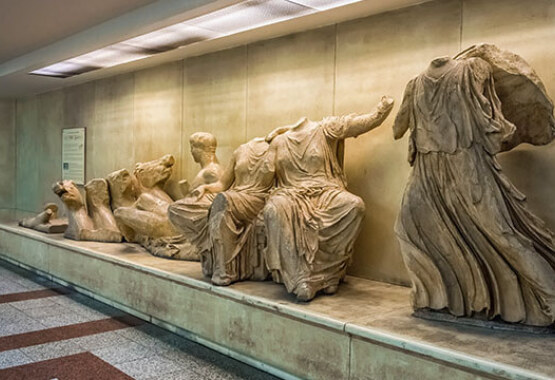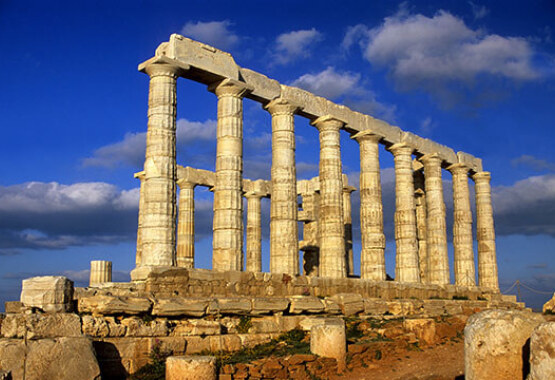
ATHENS
This wall had several doors, hence its name 'enneapylon' (nine-doored). The main entrance to the fortress was on the west side, next to a bastion, which later supported the temple of Athena Nike.
This Mycenaean wall remained in use with minor repairs and changes until 480 BC, when it was severely damaged by the Persians.
After the departure of the Persians, both the city of Athens and the Acropolis were given new walls. The northern, or Themistoclean, wall was the first to be built using material from the monuments destroyed by the Persians. North of the Erechtheion one may notice the unfinished marble drums of the Pre-Parthenon, while further to the west are fragments from the entablature (cornices, triglyphs and metopes) from the Old temple of Athena.
The southern, or Kimonean, wall was erected under Kimon after the victory at Eurymedon in 467 BC. The wall's construction necessitated the creation of a terrace along the south edge of the hill. It, too, used building material (epistyles) from the Old temple and the Pre-Parthenon. The wall remained in use and was built up to approximately the height of the Parthenon under Perikles.
After the Herulian invasion in the third century AD, another wall was built west of the Propylaia. Of its two gates, only the west one, the so-called Beulé gate, stands to this day. The Acropolis became a fortress once again and was used as such until the nineteenth century. Another south wall with two bastions, the so-called Koulas, demolished in the nineteenth century, and a second one located at the present Belvedere, were built in the thirteenth century. The southeast corner of the fortification wall was repaired one last time after the Second World War.
Acropolis Fortification Wall
Because of its geomorphology, the Acropolis has been a refuge since prehistoric times. The first, so-called 'Cyclopean' wall, was built along the top of the hill in the Mycenaean period, at approximately 1200 BC. Remains of this wall are still visible to the southeast of the Propylaia, while its course can be traced fairly accurately. A curved enclosure wall, the co-called 'Pelargic' wall mentioned by Thucydides, was also built to the northwest during this period.This wall had several doors, hence its name 'enneapylon' (nine-doored). The main entrance to the fortress was on the west side, next to a bastion, which later supported the temple of Athena Nike.
This Mycenaean wall remained in use with minor repairs and changes until 480 BC, when it was severely damaged by the Persians.
After the departure of the Persians, both the city of Athens and the Acropolis were given new walls. The northern, or Themistoclean, wall was the first to be built using material from the monuments destroyed by the Persians. North of the Erechtheion one may notice the unfinished marble drums of the Pre-Parthenon, while further to the west are fragments from the entablature (cornices, triglyphs and metopes) from the Old temple of Athena.
The southern, or Kimonean, wall was erected under Kimon after the victory at Eurymedon in 467 BC. The wall's construction necessitated the creation of a terrace along the south edge of the hill. It, too, used building material (epistyles) from the Old temple and the Pre-Parthenon. The wall remained in use and was built up to approximately the height of the Parthenon under Perikles.
After the Herulian invasion in the third century AD, another wall was built west of the Propylaia. Of its two gates, only the west one, the so-called Beulé gate, stands to this day. The Acropolis became a fortress once again and was used as such until the nineteenth century. Another south wall with two bastions, the so-called Koulas, demolished in the nineteenth century, and a second one located at the present Belvedere, were built in the thirteenth century. The southeast corner of the fortification wall was repaired one last time after the Second World War.




